

I can explain how to recover a substance from a solution.
Children investigate the best place to put a cup of salt solution so that the water evaporates most quickly. They choose 4 locations and measure the amount of water in each container over the course of 7 days. They transfer their results to a line graph and use this to answer the question.
I can group materials according to their properties.
Children investigate the properties of 10 different materials. They predict and then investigate whether the materials are electrical conductors, transparent, strong thermal conductors or magnetic. They record their results in a table, and then complete a Venn diagram containing 2 intersecting sets, choosing 2 properties by which to group the materials.

3 pages
I can investigate which materials are soluble in water.
Children investigate whether sand, sugar, salt, flour or iron filings will dissolve in water. They record their results in a table and then display them in a single-set Venn diagram. They consider how they could separate the mixtures and solutions.

2 pages
I can investigate the hardness of materials and place them in order of hardness.
Children investigate whether 5 different materials can be scratched by 4 different objects of increasing hardness. They use their results to place the materials in order of hardness.
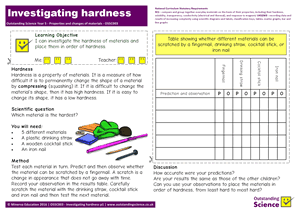
1 page
I can suggest ways in which different mixtures can be separated.
Children consider 6 different mixtures / solutions and discuss the best way to separate each. They attempt to separate them using their chosen method. They discuss whether their method worked and why.
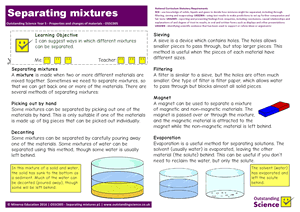
3 pages
I can explain why materials are used for different purposes.
Children identify the materials that 4 different objects are made from and explain why they have been chosen with reference to their physical properties. Next, they describe the physical properties and uses of 6 different materials - metals, plastics, wood, fabrics, glass and leather. They cut and paste or write their own descriptions.
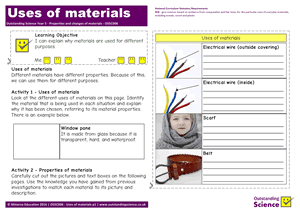
3 pages
I can explain the advantages of new materials and how they were created.
Children learn about the origins of Post-It Notes, wrinkle-free cotton, polar fleece and Gore-Tex. They complete an information text, showing when and by whom they were invented, their advantages and disadvantages, and common applications.
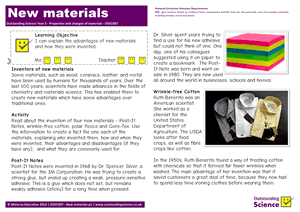
3 pages
I can identify if a change is easily reversible and how to reverse it.
Children examine 11 different physical changes of materials. They identify whether they can be easily reversed and explain how or why.
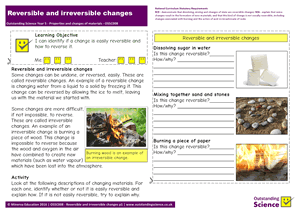
2 pages